Spraetter's Guide to Sweden
Table of Contents
- Introduction
- Overview
- Enemies And Potential Allies
- Your First Turn
- Master of the Baltic Sea
I. Introduction
Sweden, the country in the north, were polar bears roam the streets and every woman is blond and beautiful.
At the start of the setting for Empire: Total War, Sweden has been a major European power for a little more than 50 years. The 30 Years' War saw Sweden rise from a regional power to a nation that matters, most of all thanks to the genius of Gustavus II Adolphus. The Swedish Empire is an aggressive Empire, hungry for conquests and to assert it's rightful place amongst the great powers of the world.
At the start of the 18th century, however, the Swedish Empire is in danger of declining. It's three arch-enemies, Denmark, Poland-Lithuania and Russia, are allied together in an alliance with the goal of disputing, disrupting and thwarting Swedish hegemony of the Baltic Sea, and thus the source of Swedish power. Denmark has been the foremost enemy since medieval times, and Russia has always coveted the Swedish territories on the eastern shores of the Baltic. To the south lies another potential enemy in Prussia. The Prussians are no fans of Sweden, the Baltic is their link to the world beyond Europe and they will not see that link severed.
As you can see, Sweden starts with four regions under their control. The starting position may seem more precarious than it actually is, Sweden has the potential to grow extremely quickly if managed correctly.
If you take a look at the victory conditions for the Long Campaign, you'll see your goals set out in stone. The Baltic Sea and the lands that surround it are your targets. Denmark, Russia, Poland-Lithuania and Prussia are the nations that stand in your way.
II. Overview
On your first turn, your Swedish Empire looks like this:
As stated above, Sweden's starting position is really not that bad, it's actually quite a good one. You start with strong armies, a decent economy and no war, although the last is bound to change very quickly.
________________________________________________________________________________________________________
Economy
Sweden has great potential to become an economic powerhouse. You have an excellent home region in Sweden with numerous ports and towns. The ports will make sure that you have several trade lanes to fill with trade partners. Sweden and Finland also has Fur Trading Posts, giving you access to a trade commodity right off the bat. You also start out with trade agreements with both Britain and France, two lucrative trade partners. Timber and mines are all over the place, which coupled with the normal towns ensures substantial regional wealth once you get your nation developed a little bit.
What you do not have is infrastructure. The roads in your empire are of the dirt variety, and Finland doesn't even have roads. Roads are something that most people overlook. A developed infrastructure goes long ways toward improving your economy.
Another thing you lack is population. Maintaining a steady population growth in your starting regions is both hard and important. Farms are pretty scarce and of poor quality. This makes it impossible for you to raise the taxes for the lower classes, you want population growth in all of your regions, most of all Sweden which has many villages left to develop. Due to this it's advisable to keep the fishing fleet on Gotland (the island to the south of Stockholm) intact.
________________________________________________________________________________________________________
Military
Your starting armies are fairly strong and will enable you to get a head start on your enemies. The majority of your troops are located in St Petersburg and Riga, which is actually beneficial. You'll see why further down. You'll notice though that your military is of fairly poor quality. Your two units of Line Infantry and your unit of Regiment of Horse (located in Riga and outside St Petersburg) are very valuable to you, don't throw them away.The majority of your early armies are comprised of Militia and Provincial cavalry. Don't fret though, you have several military advantages over your enemies, especially over Russia. Sweden has larger units of cavalry than other nations, on large settings your cavalry units will number 60 men as opposed to 45 men for everyone else. In addition, the only nations that can field better Line Infantry than you are Britain and Prussia.
As far as generals go, you start with one decent general in Ingria. Worth mentioning is your starting admiral:
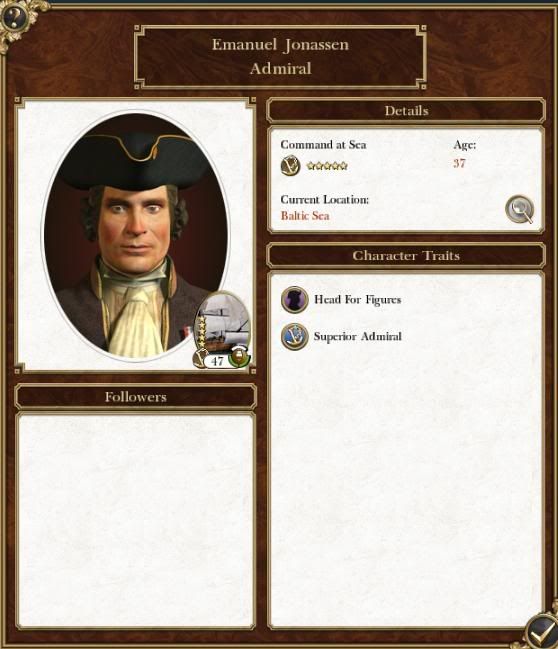
The rest of your starting navy is not very impressive, but it is enough to cope with your only enemy on the sea, Denmark.
The main point I would like to make here though, is that your empire is divided into two parts, the western and eastern shores of the Baltic Sea. These two parts will largely have to fend for themselves at the start, with their bases in Stockholm and St Petersburg respectively. Reinforcing by shuttling troops over the Baltic is not productive at the start and should not be counted on. You will need all ships you can get to deal with Denmark.
________________________________________________________________________________________________________
Government
Sweden starts out as an Absolute Monarchy, meaning that your King's traits (both the positive and the negative ones) have double the effect stated in the tooltip. You are also able to move your ministers around and replace the ones you don't like to your heart's content.
Your starting cabinet is one of your main strengths playing as Sweden. You have access to some really powerful ministers which will aid you substantially. This is why I recommend that you keep your government form and refrain from establishing a Republic. Of course, if you really want to, you shouldn't let some dude on a forum tell you that you can't.
Your King, Carl XII, starts the game as an 18 year old, so he's not going to die anyway soon. This means that you can build him up to become an extremely impressive monarch.
This is what your cabinet looks like when you start your campaign:
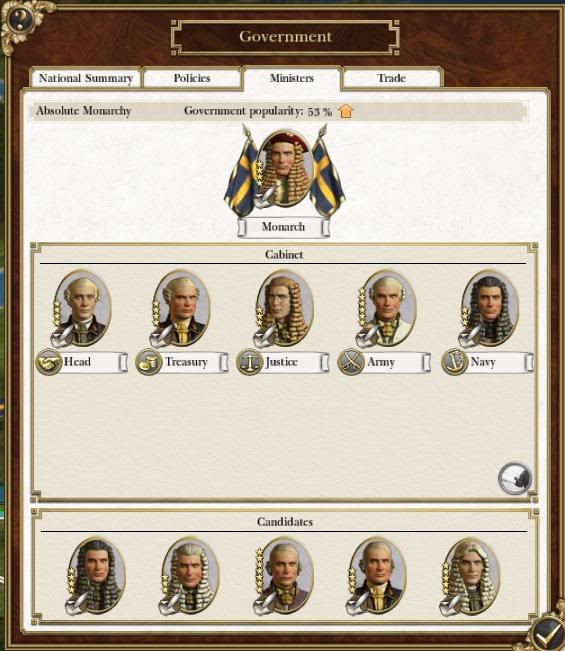
Notice the two high-ranking ministers in the "Candidates" field. They are people that we will instantly make use of. The optimal positioning of your ministers looks like this:
What I've done is that I switched places of the Head and the Army ministers, as well as moving the 7-star Candidate minister to the Justice position and moving the 5-star Candidate minister to the Navy position.
This gives you an 8-star Justice minister, which in effect means that you won't have to worry much about placing troops to placate newly conquered regions. You also have strong Head, Army and Navy ministers which means increased economic growth and less expensive armies and navies, all huge benefits.
The only weakness in your cabinet is your Treasury minister, which is a fairly big weakness. With a little luck you'll get a good minister for the Treasury position in one of the two Candidate slots. If you don't get one, keep replacing your Treasury minister with one of the Candidates, even if the candidate minister is not better. Eventually you will get a candidate that you can place as Treasury minister permanently. Make sure you keep an eye on your candidates every turn and take note of their traits.
________________________________________________________________________________________________________
Technology
You start with a School in Uppsala, north of Sweden. Your starting Gentleman is Cristopher Polhem, who has +2 research for industrial technologies.
As you will wage alot of wars and fight many battles early on, my tip is to research "Fire by Rank" as soon as you possibly can. No other technology is as useful to you in the beginning as this one. You will also need the upgraded bayonets. The research order will thus be Plug Bayonets -> Ring Bayonets -> Military Syllabus -> Fire by Rank -> Socket Bayonet. Only once you have the Socket Bayonet researched should you start researching naval and artillery technologies. The only exception to this is Canister Shot, one of the first technologies in the artillery tree. Research this one while you are constructing the improved barracks you get access to after researching Military Syllabus. The building and the researching will finish at the same time, which is perfect. You won't be wasting a single turn of researching.
In order to get a head start on your enemies tech wise, I advise you to demolish the Coaching Inn in Karlstad (located in Sweden close to the Norwegian border) and construct a School in it's stead. This will give you two Schools from the beginning, which you will need. Don't worry too much about the increase of public disorder from the second school, your Justice minister and your museum building plus government building in Stockholm will soak it up. However, if you do this, you will have to go down the museum route instead of the research laboratory route in your cultural building slot in Stockholm. This is not really a drawback, since one of Sweden's unique buildings is the Royal Museum.
Have Uppsala, with Cristopher Polhem in it, focus on getting Fire by Rank. Put any Gentleman that might spawn thanks to the School in Karlstad in Uppsala as well to speed up this process even more. With the school in Karlstad, I'd get Empiricism (one of the first technologies in the philosophical tree) first so that you can upgrade your Schools. After that, I'd go for Common Land Enclosures (one of the first technologies in the farming tree) so that you can upgrade your farms and get a population increase going. After that, I'd focus on the economic technologies in the philosophical tree, starting with Physiocracy.
As you expand you'll conquer more schools. Once you have 3-4 schools, don't be afraid to demolish the one in Karlstad if the public disorder is starting to pile up. It's only really needed in the very beginning anyway, after 30-40 turns you will have other schools to assign work to. Replace the Karlstad School with a Workshop or, if needed, a Coaching Inn.
III. Enemies And Potential Allies
As stated above, your main opponents in the contest for the Baltic Sea are Denmark, Russia, Poland-Lithuania and Prussia. There is also the minor nation of Courland, probably the most aggressive minor nation in the game, they should not be underestimated.
Denmark, Poland-Lithuania and Russia are allied and form an anti-Swedish coalition. When you declare war on one of them, the other two will join in.
________________________________________________________________________________________________________
Denmark
Let's start with Denmark, our neighbour to the west. They start with three regions, Denmark (their capital region, obviously), Norway and Iceland.
Denmark is the historical arch-enemy of Sweden, the two nations have pretty much been waging war against each other since there was a Sweden and a Denmark. Denmark will be your first obstacle to overcome, as well as your only opponent on the Baltic Sea itself. They are the only nation, except yourself, that starts with a navy. This means that you will have to beat them on the sea, or they'll blockade your trade port and starve your economy to death. Luckily, you have one advantage over them: you have a dockyard (in Ingria) where you can build more ships, should the need arise. They don't have this luxury.
In terms of economic power, both Denmark and Norway has substantial growth potential (Iceland not so much, it just doesn't earn any money). Norway is a more lucrative region than Denmark if you only look at the region wealth, but Norway has another benefit. On the south-western edge of Norway there is a port. Build a trade port here and it will connect with Sweden by land, and you can thus use this port as if it was in your home region (it will give you trade lanes and will import/export trade goods). However, Denmark houses a School and is a multi-slot city. There are plenty of villages/towns in both regions.
In terms of military power, Denmark is nothing special at all. They start out very weak and don't field any special units. They more or less exist to be conquered by you, Sweden. You have to be fairly quick about it though, as with any minor nation Denmark is more than capable to spout out full-stack armies ad infinitum if you let them.
________________________________________________________________________________________________________
Russia
To your east lies the Russian steppes, a vast and endless expanse of land. They start out with nine regions, Karelia, Muscovy (their capital region), Ukraine, Arkhangelsk, Komi, Bashikiria, Astrakhan, Taraiya and Don Viosko.
As you can see the Russian territory is so large you cannot fit it in a single screenshot.
Russia is actually not as big of a threat as they may seem. They control vast lands, yes, but the land is essentially empty. The only really economically significant region of theirs is Muscovy, which houses Moscow, their school and almost every single industrial town in their possession. The rest of Russia lacks infrastructure and industrialization. What they do have is timber and furs. However, the furs won't do them much good since they start as a landlocked nation, which means that they have to conquer the Crimean Peninsula or a coastal region in the Baltic if they want to gain access to sea-trade.
In terms of military might, Russia starts out really weak. Their Line Infantry is of poorer quality compared to yours, and your cavalry will beat their thanks to your larger cavalry unit sizes. All in all, Russia will not be able to stand against a dedicated Swedish invasion for long. As for their navy, they start out being landlocked, so there is no Russian navy for you to worry about.
You are also not alone in battling with Russia. The Ottoman Empire and it's protectorate the Crimean Khanate will also wage war against Russia, and probably Dagestan as well. In conclusion, Russia is far from your most dangerous foe.
________________________________________________________________________________________________________
Courland
Courland is an interesting minor nation. In every single campaign I've played (and not just as Sweden), they seem to want to declare war against the whole world. They are highly aggressive, and as with all minor nations, they should be watched out for.
Don't let the size of the region fool you, it's actually quite a lucrative region. It will make as much money as your Estonia & Livonia and Ingria put together. Since minor nations love to upgrade their roads, don't be surprised to see cobbled roads in Courland when you take it.
Courland starts out as a protectorate of Poland-Lithuania, so if you declare war on them, expect Poland to counter. This might not matter that much, if at all, since Poland-Lithuania is also allied with Denmark which you'll be at war with from the start. You'll end up at war with Poland any way you play it.
As you can see from the screenshot, Courland has a Governors Military Barrack, which turns the region into a very nice place through which to funnel your invasions into the southern Baltic countries. Use Courland to keep a steady stream of reinforcements to your army(ies) fighting in Poland. This frees you up to focus St Petersburg entirely on beating the Russians.
________________________________________________________________________________________________________
Poland-Lithuania
Poland-Lithuania will probably be the nation that puts up the biggest fight against you. They control a large chunk of eastern Europe, and you'll have to battle through pretty much all of it. The regions under their control are West Prussia, Poland, Lithuania, Belarus & Volhynia and Galicia & Podolia.
Military speaking Poland-Lithuania will be far from a walk in the park. Their Line Infantry is on par with yours, and even though your cavalry is more numerous, theirs is of very high quality. Their Winged Hussars have absolutely lethal charges.
They also have the economy with which to back up a serious army. Poland is a pretty developed region with good growth potential. The farms in the Polish regions are very fertile, so their population growth is high. What they lack is a trade port, so they cannot engage in sea trade which is something of an Achilles heel.
As is the case with Russia, you are not alone in having your eyes set on Poland's lands. Prussia and perhaps Austria will also make grabs for it.
________________________________________________________________________________________________________
Prussia
Finally we have Prussia. The nation starts out very small, but it has an extremely high potential expansion rate thanks to it's strong starting army, it's very fine military units, proficient military commanders and talented government ministers. Prussia starts with two regions, Brandenburg (their capital region) and East Prussia. Notice that their two regions are not connected with each other.
As stated above, Prussia is extremely strong for it's small size. Their starting army is most impressive, and their whole unit roster is simply excellent.
Brandenburg is one of the most lucrative regions in central Europe and can grow into an economic powerhouse. They also have ready access to a trade port on the Baltic Sea, so they are not incapable of sea trade like Russia and Poland-Lithuania.
It's a little hard to predict how big a challenge Prussia will put up. In my campaigns I've seen them wipe out Austria and Poland-Lithuania as well as most of the German states on their own, but I've also seen them reduced to Brandenburg as their only region for a whole game.
Your best bet is to count on them to put up a serious fight. If you're lucky though, they'll be occupied in the south against Austria, which will mean that Brandenburg will be mostly empty of troops. This can enable you to sneak in the back door via landing troops from the sea, or your Polish territories. Brandenburg is the only Prussian region you need for the campaign objectives anyway.
________________________________________________________________________________________________________
Potential Allies
Even though you are more than capable of taking on your foes by yourself, having alliances can really help. You start out on good terms with Britain and France, trading with both of them. The Ottomans will also start to like you when you get your first trade deal with them, and they won't start hating you just because you're conquering Northern Europe.
An alliance between you and the Ottomans is something very beneficial, they border every single nation you will fight in Eastern Europe, and if you want to take on the Austrians they can help with that too.
Britain is another noteworthy potential ally. They are a naval power and a trading power, getting an alliance with them is beneficial for many reasons. They have a large presence in North America, which means that you can land your troops into British territory and not have to land your troops on enemy territory directly from the sea. This is extremely useful if you want to make a stab into North America, against the natives or the French. Britain's sea power will also serve you well, particularly in Europe. Britain will keep the water of the Eastern Atlantic Ocean empty save for themselves and the Dutch, which means that you, as their ally, can cruise around to your hearts content.
IV. Your First Turn
Right, we're set to begin with your first turn as Emperor of Sweden. I just though I'd put in this section since the first turn can have an enormous impact on the rest of the campaign.
________________________________________________________________________________________________________
Sweden
The first thing you want to do is get your cabinet in order. See above under Introduction and sub-category Government on what to do.
Next, move Christopher Polhem into Uppsala and start researching Plug Bayonets. Also demolish the Coaching Inn in Karlstad so that we can construct a School in it's stead the next turn. See Introduction and Technology for more information.
Having done that, we need to set out some priorities and goals, both long-term and short-term. Your immediate and most pressing concern is to blitz Denmark out of the European mainland by taking Norway and Denmark.
Our first target will be Norway. The first thing we move is our navy, we position it in the waters separating Denmark and Sweden, so that Danish troops cannot cross into Sweden.
This will keep our southern frontier safe until Norway is ours. The Danish fleet will most probably attack yours, but this is a fight you should win since you have two frigates against their one, as well as an outstanding admiral.
The next thing on the agenda is to prepare an invasion army in Stockholm. Select your army that's located outside of Stockholm and disband the unit of pikemen to save a few gold on upkeep. Next move all your units that are in Stockholm into your army outside the city. Then queue up three units of Line Infantry in Stockholm.
This means that you will have an army of a general, two provincial cavalry, two militia, three line infantry and a cannon on turn 2. This will be enough to invade Norway with.
The last thing we do in Sweden is to build an Indiaman in our trade port in southern Sweden. Keep building these ships as fast you can. I usually get two trade nodes in the Ivory Coast, one in the Straits of Madagascar and one in the East Indies before the rest are taken by the AI. You really need to hurry up building these ships though since you're so far from the trade theatres. They are a priority.
________________________________________________________________________________________________________
East of the Baltic Sea
On the other side of the Baltic Sea, however, our priorities are a little different. We will basically be spending our resources to defeat Denmark in a Blitzkrieg á la 1939. This means that we will be focusing on defense around St Petersburg and Riga. Since Poland and Russia are allied with Denmark, they'll come knocking as soon as we attack Denmark. Therefore our goal will be to keep them at bay until Denmark is defeated, at which point we'll be able to redirect our resources into fighting in the Baltic countries.
There is one notable exception to this though. Courland. We're hitting those guys on turn three, before they have a chance to build an army. This will help tremendously.
Select the army outside St Petersburg. Send the general and the unit of pikemen into St Petersburg and queue up a unit of militia. Then move the rest of the army from outside of St Petersburg towards Riga. In Riga you queue a unit of militia (also queue one unit of militia up the next turn). Combine the army in Riga with the one coming from St Petersburg when it get's there, and you can invade Courland.
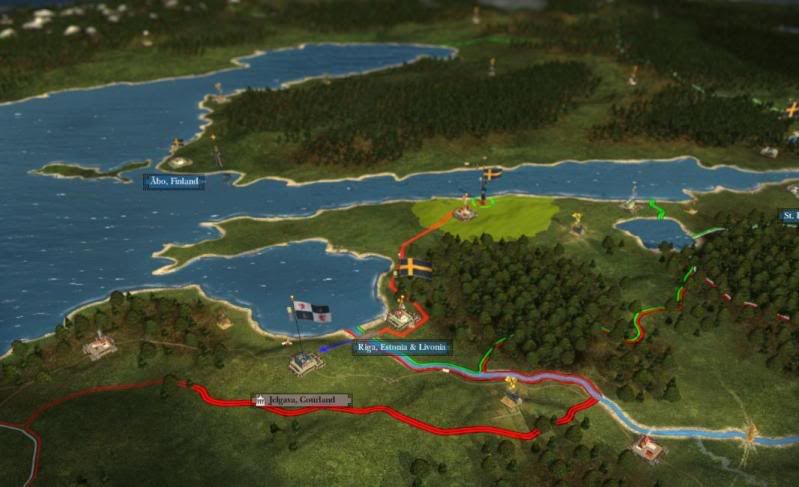
_______________________________________________________________________________________________________
Other than the things mentioned above, I suggest you do the following:
- Move the Rake located outside St Petersburg towards Moscow, so that you can keep an eye on their build-up.
- Build Farms in Sweden and Ingria.
- Build Roads and the Mine in Finland.
- Construct Barracks in Ingria.
V. Master of the Baltic Sea
If you follow the advice in the previous chapter, you should be attacking Norway and Courland at the same time, turn three. This is where all hell breaks loose. You should be able to take Norway and Courland with the armies that you have on turn three. We are now a little closer to controlling the Baltic Sea.
_______________________________________________________________________________________________________
The Western Frontier
After taking Norway, that army will not have to stay there thanks to your awesome Justice-minister. Simply repair the building, then move your army south towards Denmark, retraining your units as you go. Don't forget to demolish the Fishing Port in Norway so that you can replace it with a Trade Port.
You should have trained 2-4 units of Line Infantry in Stockholm to meet up with your Norway army on it's way towards Denmark. The amount of units will depend on your battle difficulty setting and how many casualties you've taken.
Now, if you've lost the naval battle in the straits between Sweden and Denmark you're facing a set back. If the Danish navy can block your access and your trade port at the same time, that's really bad news, so make sure you win that naval battle (which shouldn't be an issue since you have the advantage). If you should lose your navy, you'll have to build a ship in Norway, embark your troops and then invade Denmark via sea from the north.
You should have control of Denmark between turn 7 and 10. Now, after you've taken Denmark, you have two options. If Poland-Lithuania and Russia are doing considerable damage on the other side of the Baltic, leave a garrison that is large enough to control the Danish population and sail the rest over the sea to help your eastern regions out. If you do this, simply offer Denmark a peace treaty with no other conditions, they will accept and you won't have to think about them ever again.
What I usually do instead, is to retrain my army in Denmark to full strenght, maybe recruit a few units so that I have 14 or so of them. I then embark them on the Swedish navy and set sail for America. The two Pirate islands are your goal, they are usually very easy to take out. This will earn you two warm water ports and some sugar. On the way, stop by Iceland and wipe the pesky Danish from the face of the Earth.
From these two islands you can pretty much do anything you want. The settlement on the Leeward Islands can train good quality troops, so you can recruit armies directly in America. With these armies you can either go fight the Cherokees to get a foothold in North America, or you can pick a fight with Spain/France and take their colonies. If you'd rather go to India, simply embark them on your navy and sail there. Mysore is an excellent invasion point, but be prepared to fight multiple stacks. If Mysore is under Marathas' control, I suggest invading a Mughal coastal region, most preferably Bengal. If Maratha has taken Mysore they're about to conquer the whole of India, so take the Mughal lands before they do. Hindustan + Bengal makes you tons of money.
_______________________________________________________________________________________________________
The Eastern Frontier
While you are busy fighting Denmark in the west, Poland-Lithuania and Russia will start to send troops into your regions on the eastern shores of the Baltic. The mission here is to hold Courland, Estonia & Livonia and Ingria until you've secured Denmark, at which point you can start focusing your resources on fighting in the east. It's ok if you don't manage to hold all three regions, that can be quite challenging. Try to raise as many units as you can to help hold the hordes from the steppes at bay. I generally like to have a strong defensive force between Riga and St Petersburg. This army can beat off invading armies in both regions, or retake a region that has been lost. I generally keep a garrison in Courland since I don't want to lose that province, it's such a nice springboard into eastern Europe.
Once Denmark is dealt with, assemble two armies consisting of cavalry, Line Infantry and cannons. Leave any militia units in the regional headquarters as garrisons and safe-guards. Disband any pikemen you might have left.
One army should be trained out of Courland. This army will be used to press onward into Poland-Lithuania. Supply this army with reinforcements from Courland.
St Petersburg will focus on Russia. You should have your Rake around Moscow so that you can see the Russians' strength. March an army you judge sufficient to take Moscow towards the city and take it. While you do that, send your Protestant Missionary located in Ingria up towards Karelia to check out that garrison's strength. Assemble another force and march it through the forests and take Karelia.
I don't go further into Russia than Muscovy and Karelia. It's generally not worth it, it takes such a long time to move your armies around. In addition, I dislike wiping out major European factions, the campaign get's much more enjoyable if you let them live. I also leave Galicia & Podolia to Poland-Lithuania for this very reason. When you've taken Karelia and Muscovy, Russia will agree to peace, as long as you only offer peace and don't demand anything else. Leave a few units as garrisons and move the bulk of your forces in Russia towards more productive things, like helping out with Poland-Lithuania or Prussia.
With only Galicia & Podolia left, Poland-Lithuania will be begging you for peace as well. Now you can focus on Prussia and Central Europe.
_______________________________________________________________________________________________________
Prussia, the Southern Frontier
The only provinces you want for your Baltic domination are Brandenburg and East Prussia. By the time you're done with Poland-Lithuania and Russia, Prussia has usually expanded at least into Silesia, sometimes Saxony and Bohemia & Moravia as well (or even further into Austrian lands). The point of this is that if Prussia is engaged to the south, Brandenburg and East Prussia are generally yours for the taking. Simply invade them with your forces left over from the conquest of Poland-Lithuania. By now you have the economy to train armies large enough to take on Prussia even if they're still strong at home.
After taking Brandenburg and East Prussia, Prussia will accept peace as easily as Poland-Lithuania and Russia did.
_______________________________________________________________________________________________________
Master of the Baltic Sea
After my wars against Denmark, Russia, Poland-Lithuania and Prussia, my European settlements looks like this:
The Baltic Sea and surrounding territories are all mine, but Prussia, Poland and Russia are still alive, which adds alot of extra fun to the campaign.
At this point I like to stop my territorial expansion in Europe altogether. I replenish my armies, repair the buildings and start to focus on upgrading every single road and town in my entire domain. The armies I used to take this territory I usually divide in half. One half will stay behind in Europe and garrison my settlements so that the AI can't just waltz in and re-take everything. The other half I send into the sunset, to America or India.
_______________________________________________________________________________________________________
Making Money
Making money as Sweden is far from hard. The turning point comes when you capture Norway and gain access to another trade port, enabling you to have 4 trade routes. You can have an income of 10,000 per turn at turn 10. Since you start with trade agreements with Britain and France, hand the extra two out to the Ottoman Empire and Marathas. Once you research Division of Labour, enabling you to upgrade your trade ports, you'll get two more trade routes. Give one of them to the Mughals if they're still around and you're not at war with them. Persia and Spain are two other nice trade partners.
Here are a few general pointers on how to get your economy going and what to prioritize:
- Keep sending those Indiamen to your trade spots in the trade theatres. Since you will have a large number of trade partners, these ships really pay off.
- Focus your spending on roads, upgrading your Fur Trading Posts and your towns. Only build the first step of the mines, don't upgrade them. You get a much larger return from your money elsewhere.
- Upgrade the Government Buildings in regions such as Sweden, Norway, and Finland. The ones in conquered regions will almost always already be upgraded as far as they go.
- Colonies are the key to making the big bucks in this game. Sending your Denmark-army to take the Pirate islands in the Caribbean as described previously will give you sugar, which generally has a quite high price.
- Make sure your Treasury Minister is good at his job.
- Research the economic enlightenment technologies (such as Division of Labour, Wealth of Nations etc) as fast as you can. Aside from the economic bonuses they give you (which are substantial), they also allow you to upgrade your trade ports, which means more trade lanes, which equals more trade partners and more cash.
That's it!
I hope that the Guide has been helpful. Thanks for reading, have fun gaming.




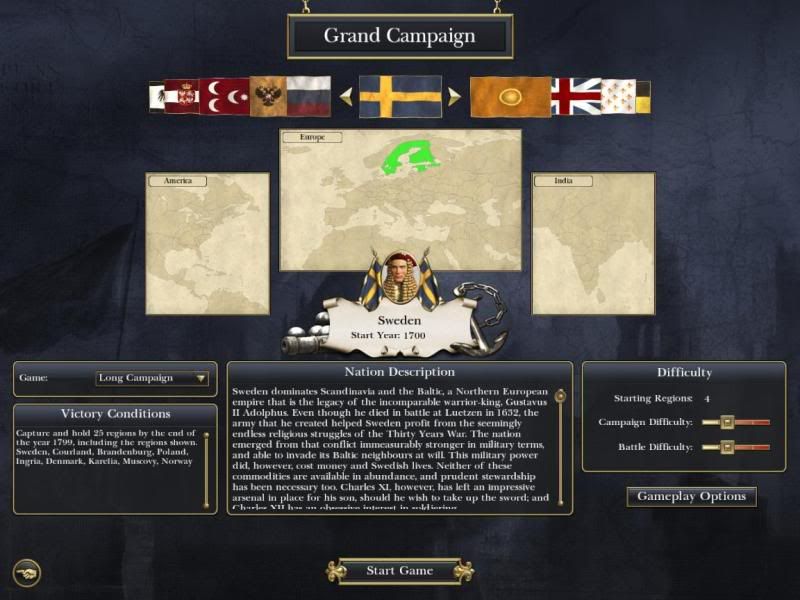
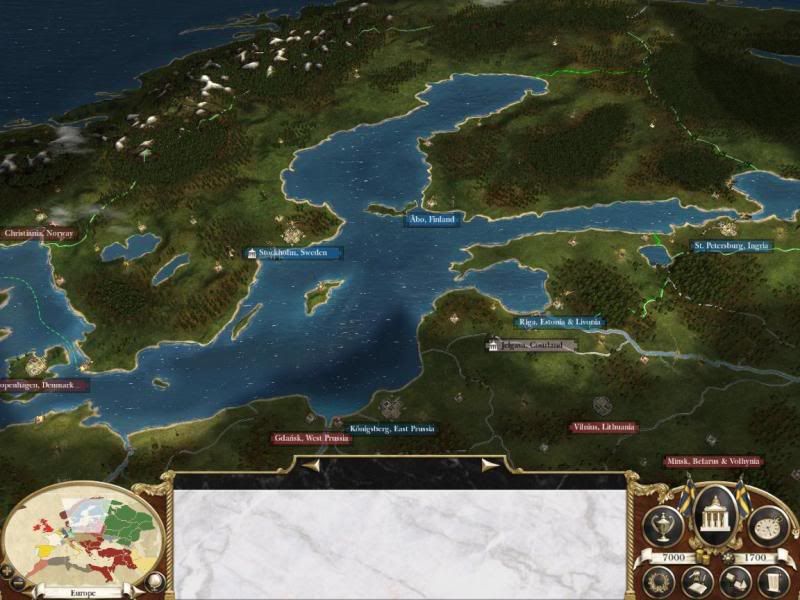



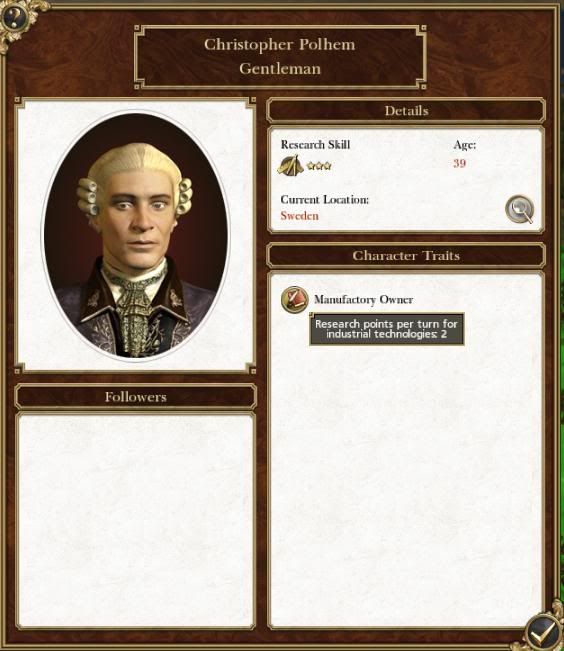




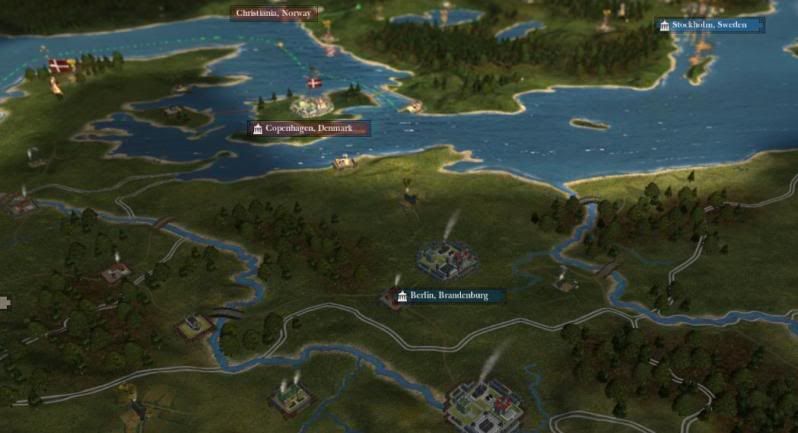
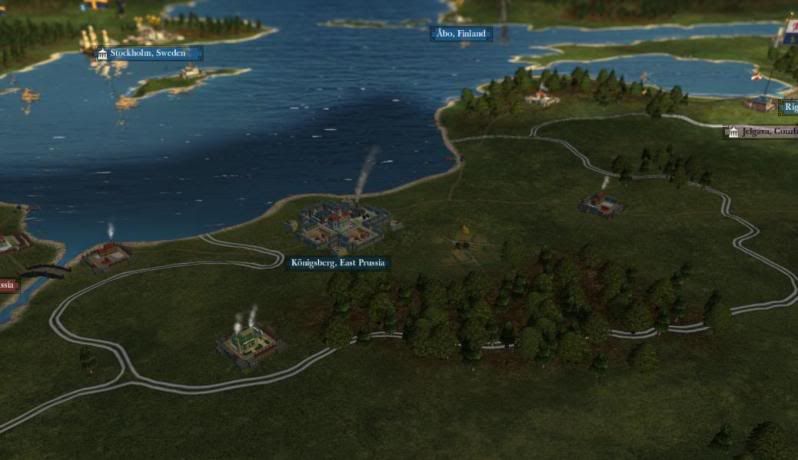
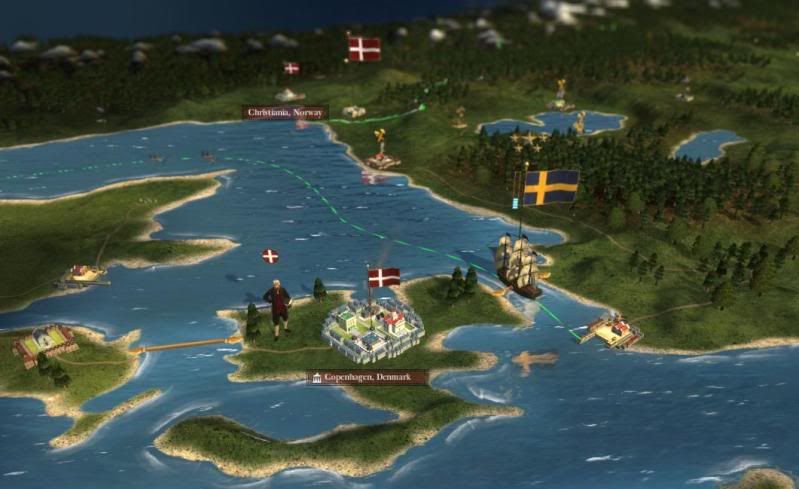
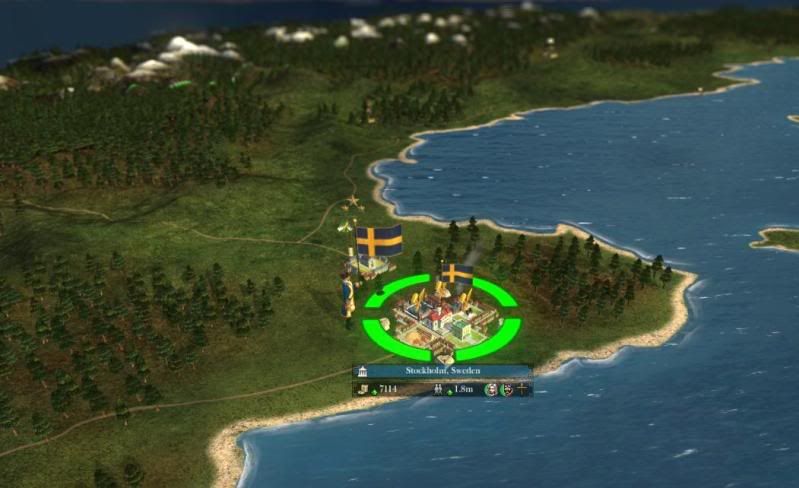


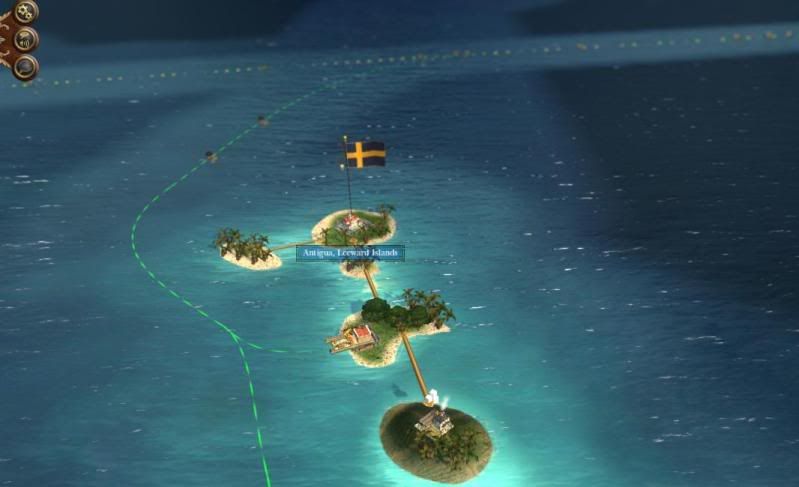
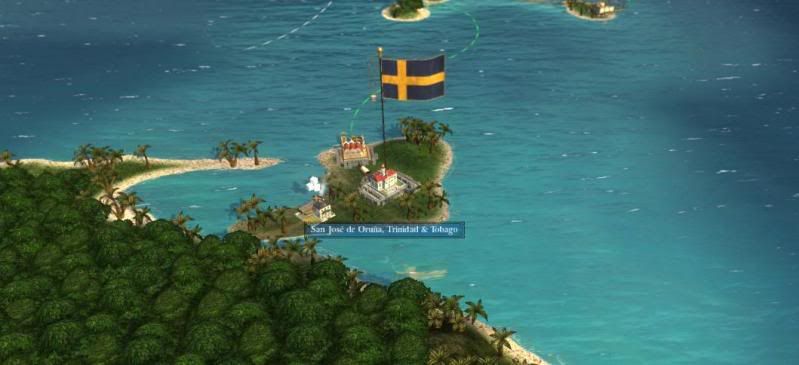
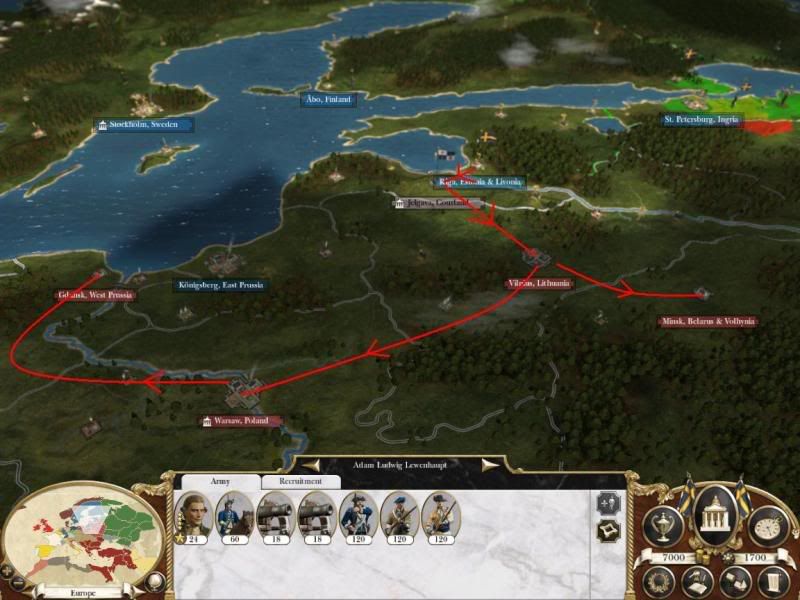
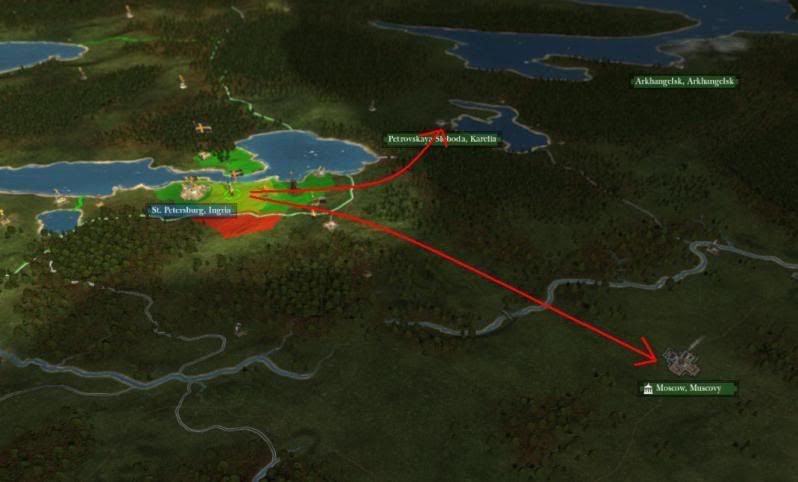
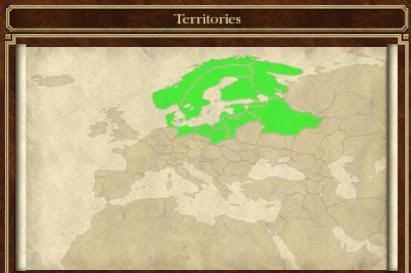

 Reply With Quote
Reply With Quote







